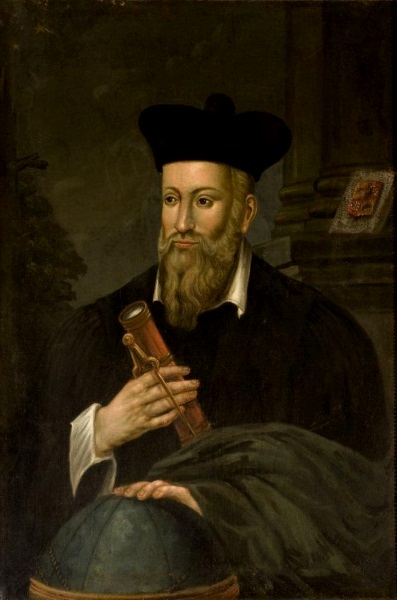Nostradamus was born on either the 14
or 21 of December 1503 in Saint-Rémy-de-Provence, Provence, France,
where his claimed birthplace still exists, and baptized Michel. He was
one of at least nine children of notary Jaume (or Jacques) de
Nostredame and Reynière, granddaughter of Pierre de Saint-Rémy who
worked as a physician in Saint-Rémy. Jaume's family had originally been
Jewish, but his father, Cresquas, a grain and money dealer based in
Avignon, had converted to Catholicism around 1459–1460, taking the
Christian name "Pierre" and the surname "Nostredame" (Our Lady), the
saint on whose day his conversion was solemnised. The earliest ancestor
who can be identified on the paternal side is Astruge of Carcassonne,
who died about 1420. Michel's known siblings included Delphine, Jean,
Pierre, Hector, Louis, Bertrand, Jean II and Antoine. Little else is
known about his childhood, although there is a persistent tradition
that he was educated by his maternal great grandfather Jean de St.
Rémy. A tradition which is somewhat undermined by the fact that the
latter disappears from the historical record after 1504, when the child
was only one year old.
At the age of 14 Nostradamus entered the
University of Avignon to study for his baccalaureate. After little more
than a year, he was forced to leave Avignon when the university closed
its doors during an outbreak of the plague. After leaving Avignon,
Nostradamus, by his own account, traveled the countryside for eight
years from 1521 researching herbal remedies. In 1529, after some years
as an apothecary, he entered the University of Montpellier to study for
a doctorate in medicine. He was expelled shortly afterwards by the
student procurator, Guillaume Rondelet, when it was discovered that he
had been an apothecary, a "manual trade" expressly banned by the
university statutes, and had been slandering doctors. The expulsion
document, still exists in the faculty library. However, some of his
publishers and correspondents would later call him "Doctor". After his
expulsion, Nostradamus continued working, presumably still as an
apothecary, and became famous for creating a "rose pill" that
purportedly protected against the plague.
 (Nostradamus' claimed birthplace before its recent renovation, Saint-Rémy-de-Provence)
| (Nostradamus' house at Salon-de-Provence, as reconstructed after the 1909 Provence earthquake)
In 1531 Nostradamus was invited by
Jules-César Scaliger, a leading Renaissance scholar, to come to Agen.
There he married a woman of uncertain name (possibly Henriette
d'Encausse), who bore him two children. In 1534 his wife and children
died, presumably from the plague. After their deaths, he continued to
travel, passing through France and possibly Italy.
On his return
in 1545, he assisted the prominent physician Louis Serre in his fight
against a major plague outbreak in Marseille, and then tackled further
outbreaks of disease on his own in Salon-de-Provence and in the
regional capital, Aix-en-Provence. Finally, in 1547, he settled in
Salon-de-Provence in the house which exists today, where he married a
rich widow named Anne Ponsarde, with whom he had six children, three
daughters and three sons. Between 1556 and 1567 he and his wife
acquired a one thirteenth share in a huge canal project, organised by
Adam de Craponne, to create the Canal de Craponne to irrigate the
largely waterless Salon-de-Provence and the nearby Désert de la Crau
from the river Durance.
After another visit to Italy,
Nostradamus began to move away from medicine and toward the "occult",
although evidence suggests that he remained a Roman Catholic and was
opposed to the Protestant Reformation. But it seems he could have
dabbled in horoscopes, necromancy, scrying, and good luck charms such
as the hawthorn rod. Following popular trends, he wrote an almanac for
1550, for the first time in print Latinising his name to Nostradamus.
He was so encouraged by the almanac's success that he decided to write
one or more annually. Taken together, they are known to have contained
at least 6,338 prophecies, as well as at least eleven annual calendars,
all of them starting on January 1 and not, as is sometimes supposed, in
March.
|
He then began his project of writing a book of one
thousand mainly French quatrains, which constitute the largely undated
prophecies for which he is most famous today. Feeling vulnerable to
opposition on religious grounds, however, he devised a method of
obscuring his meaning by using "Virgilianised" syntax, word games and a
mixture of other languages such as Greek, Italian, Latin, and
Provençal. For technical reasons connected with their publication in
three installments, the last fifty-eight quatrains of the seventh
"Century" have not survived in any extant edition.
The
quatrains, published in a book titled Les Propheties (The Prophecies),
received a mixed reaction when they were published. Some people thought
Nostradamus was a servant of evil, a fake, or insane, while many of the
elite evidently thought otherwise. Catherine de' Medici, wife of King
Henry II of France, was one of Nostradamus' greatest admirers. After
reading his almanacs for 1555, which hinted at unnamed threats to the
royal family, she summoned him to Paris to explain them and to draw up
horoscopes for her children. At the time, he feared that he would be
beheaded, but by the time of his death in 1566, Queen Catherine had
made him Counselor and Physician to her son, the young King Charles IX
of France.
Some accounts of Nostradamus' life state that he was
afraid of being persecuted for heresy by the Inquisition, but neither
prophecy nor astrology fell in this bracket, and he would have been in
danger only if he had practised magic to support them. In 1538 he came
into conflict with the Church in Agen after an Inquisitor visited the
area looking for anti-Catholic views. His brief imprisonment at
Marignane in late 1561 was solely because he had violated a recent
royal decree by publishing his 1562 almanac without the prior
permission of a bishop.
|



